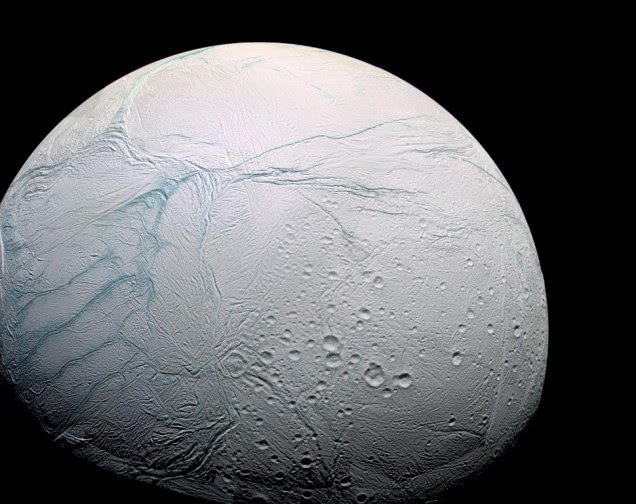The idea that Enceladus may host a subsurface ocean is nothing new. Back in 2005, NASA's Cassini spacecraft beamed back images showing what appeared to be plumes of water vapor spewing out from fractures, called "tiger stripes," near the icy moon's southern pole (similar to what was recently detected on Europa, another icy moon with a subsurface ocean). By itself, these plumes didn't prove that liquid water existed under the ice. It's conceivable, for example, that massive tectonic forces exerted by Saturn's gravity was creating friction along the plates of ice, resulting in cracks and the jettisoning of liquid water.
But now, after an analysis of gravity measurements made by Cassini from 2010 to 2012, astronomers have confirmed that a large reservoir of liquid water exists underneath Enceladus's icy surface. And just as importantly, they've confirmed that the tiny moon is a differentiated celestial body; it's comprised of two layers — an external icy layer and an internal rocky core made up of silicates. Excitingly, this layer of silicate rock, in conjunction with liquid water, means that Enceladus features a potentially habitable environment — one that could be even more hospitable to life than Europa.
A Negative Gravity Anomaly
Geophysical data provided by Cassini revealed a rather strange thing about Enceladus. The moon's southern region featured a negative gravity anomaly. These anomalies exist when there's less mass in a particular region that what would be expected in an otherwise uniform spherical body. Enceladus has a depression on its surface at the south pole, so scientists were expecting to find this negative mass anomaly. But what they weren't expecting to find was one so large; it was considerably bigger than what would be predicted by the depression alone.
What this suggested to the astronomers, a team consisting of Luciano Iess of Sapienza University of Rome and David Stevenson, a professor of Planetary Science at Caltech, is that a denser mass must exist under the surface to compensate. And because water is denser than ice, the only reasonable explanation is that liquid water resides underneath.
The Southern Reservoir
Unlike Europa and its global subsurface ocean, Enceladus has an ocean in the southern regions. It extends from the south pole in all directions to about 50 degrees south — about half-way to the equator. This ocean is deepest near the south pole. Astronomers haven't ruled out the possibility of something larger, but the current data does not support it.
Enceladus, which is only 310 miles (500 km) in diameter, features a large water reservoir about 18 to 25 miles (30 to 40 km) beneath the icy surface. This liquid layer is about 5 to 6 miles (8 to 10 km) deep. Its total water volume is similar to that of Lake Superior's — the largest of the Great Lakes.
That Enceladus can host liquid water comes as somewhat of a surprise. The surface temperature of the moon is -180 degrees C (-292 degrees F). Speaking at a press conference yesterday, Stevenson conjectured that Saturn's intense gravitational forces are likely responsible for creating the required energy. Alternately, there could be some kind of internal energy source. Enceladus's small size may account for its partial ocean (Europa is much bigger — about the size of our moon).
The scientists aren't entirely sure why the ocean is located in the south, but it's likely that the flexing and heating of the ice is pronounced in the polar regions — a process that feeds back on itself creating increasing amounts of lubrication.
As for the plumes, they're probably caused by tidal forces that are flexing and heating the ice. A kind of plumbing system likely connects the ocean through the cracks to the surface.
The Importance of Silicates to Life
As noted, Enceladus features a rocky core made up of silicates and at a density of about 2.4 grams per cubic centimeter. This is exciting for astrobiologists because silicate provides many materials essential for life, such as phosphorous and sulphur. And in fact, scientists have already detected evidence of salts and organic molecules in the plumes and near the tiger stripes. Because the water is in contact with silicates in the presence of energy, chemical reactions are possible. Taken together, this means that Enceladus is — in the words of the researchers — "an attractive place to look for life."
Interestingly, astronomers don't know if Europa hosts organic molecules or silicates (water ice in contact with liquid water behaves much differently). But Enceladus does. This means that Enceladus may actually be a better candidate for life than Europa.
Indeed, one of the main take-aways from this research is that potentially habitable environments are emerging in completely unexpected places. In time, the outer solar system may yield a cornucopia of life-friendly environments. Given that Titan, Callisto and Ganymede may also host subsurface oceans (still unconfirmed), a certain kind of "habitablezone for outer gas giants" may actually exist — though the potential for these remote regions to foster the development of intelligent life is unknown and likely at an extremely low probability.
Next Steps
Looking ahead, astronomers would like to gain a better understanding of the moon's interior structure. They'd like to know the exact location, size, and shape of the reservoir that supplies the jets. Measuring gravity anomalies will continue to inform this research.
As for future missions, spectrographic measurements of the plumes could yield more insights into the molecular makeup of the water.
Source: io9
Read the entire study at Science: "The Gravity Field and Interior Structure of Enceladus."




No comments:
Post a Comment